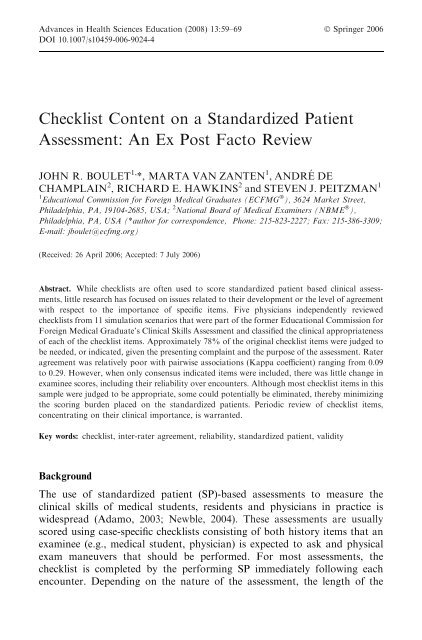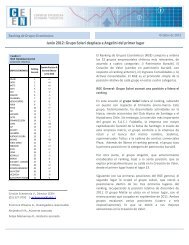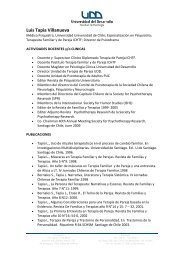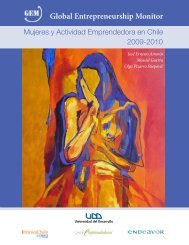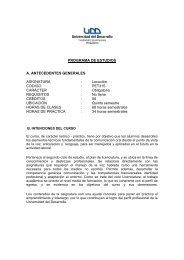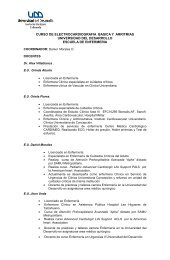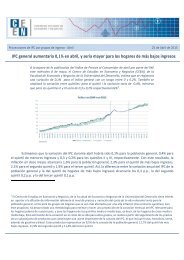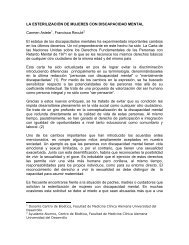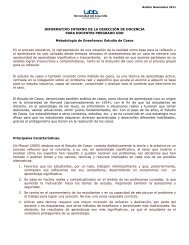Checklist Content on a Standardized Patient Assessment ... - Springer
Checklist Content on a Standardized Patient Assessment ... - Springer
Checklist Content on a Standardized Patient Assessment ... - Springer
You also want an ePaper? Increase the reach of your titles
YUMPU automatically turns print PDFs into web optimized ePapers that Google loves.
Advances in Health Sciences Educati<strong>on</strong> (2008) 13:59–69 Ó <strong>Springer</strong> 2006<br />
DOI 10.1007/s10459-006-9024-4<br />
<str<strong>on</strong>g>Checklist</str<strong>on</strong>g> <str<strong>on</strong>g>C<strong>on</strong>tent</str<strong>on</strong>g> <strong>on</strong> a <strong>Standardized</strong> <strong>Patient</strong><br />
<strong>Assessment</strong>: An Ex Post Facto Review<br />
JOHN R. BOULET 1, *, MARTA VAN ZANTEN 1 , ANDRE´ DE<br />
CHAMPLAIN 2 , RICHARD E. HAWKINS 2 and STEVEN J. PEITZMAN 1<br />
1 Educati<strong>on</strong>al Commissi<strong>on</strong> for Foreign Medical Graduates (ECFMG Ò ), 3624 Market Street,<br />
Philadelphia, PA, 19104-2685, USA; 2 Nati<strong>on</strong>al Board of Medical Examiners (NBME Ò ),<br />
Philadelphia, PA, USA (*author for corresp<strong>on</strong>dence, Ph<strong>on</strong>e: 215-823-2227; Fax: 215-386-3309;<br />
E-mail: jboulet@ecfmg.org)<br />
(Received: 26 April 2006; Accepted: 7 July 2006)<br />
Abstract. While checklists are often used to score standardized patient based clinical assessments,<br />
little research has focused <strong>on</strong> issues related to their development or the level of agreement<br />
with respect to the importance of specific items. Five physicians independently reviewed<br />
checklists from 11 simulati<strong>on</strong> scenarios that were part of the former Educati<strong>on</strong>al Commissi<strong>on</strong> for<br />
Foreign Medical Graduate’s Clinical Skills <strong>Assessment</strong> and classified the clinical appropriateness<br />
of each of the checklist items. Approximately 78% of the original checklist items were judged to<br />
be needed, or indicated, given the presenting complaint and the purpose of the assessment. Rater<br />
agreement was relatively poor with pairwise associati<strong>on</strong>s (Kappa coefficient) ranging from 0.09<br />
to 0.29. However, when <strong>on</strong>ly c<strong>on</strong>sensus indicated items were included, there was little change in<br />
examinee scores, including their reliability over encounters. Although most checklist items in this<br />
sample were judged to be appropriate, some could potentially be eliminated, thereby minimizing<br />
the scoring burden placed <strong>on</strong> the standardized patients. Periodic review of checklist items,<br />
c<strong>on</strong>centrating <strong>on</strong> their clinical importance, is warranted.<br />
Key words: checklist, inter-rater agreement, reliability, standardized patient, validity<br />
Background<br />
The use of standardized patient (SP)-based assessments to measure the<br />
clinical skills of medical students, residents and physicians in practice is<br />
widespread (Adamo, 2003; Newble, 2004). These assessments are usually<br />
scored using case-specific checklists c<strong>on</strong>sisting of both history items that an<br />
examinee (e.g., medical student, physician) is expected to ask and physical<br />
exam maneuvers that should be performed. For most assessments, the<br />
checklist is completed by the performing SP immediately following each<br />
encounter. Depending <strong>on</strong> the nature of the assessment, the length of the
60<br />
JOHN R. BOULET ET AL.<br />
encounter, and the complexity of the simulated patient complaint, the<br />
number of items can range from a few to dozens.<br />
While much research has been c<strong>on</strong>ducted investigating the scoring and<br />
utility of case-specific history taking and physical examinati<strong>on</strong> checklists<br />
(Boulet et al., 2002;Whelan et al., 2005;), few studies have specifically<br />
focused <strong>on</strong> issues c<strong>on</strong>cerning how the cases, and associated checklists, are<br />
developed. For a clinical skills exam to be valid, the checklists must c<strong>on</strong>sist of<br />
items that are truly essential to the task. A review by Gorter et al. (2000)<br />
c<strong>on</strong>cluded that too few researchers are fully describing their methods of<br />
checklist c<strong>on</strong>structi<strong>on</strong>. Moreover, there is little, if any, published evidence<br />
that specifically links checklist c<strong>on</strong>tent to the evidence-based medical literature.<br />
All this informati<strong>on</strong> is necessary for others to be able to effectively<br />
evaluate the validity of the checklists, a particularly critical issue when the<br />
scores are being used for credentialing or licensure decisi<strong>on</strong>s.<br />
While most checklists used for assessment purposes are developed by a<br />
group of pers<strong>on</strong>s, including medical specialists, there is a lack of research <strong>on</strong><br />
issues related to the level of agreement am<strong>on</strong>gst individuals <strong>on</strong> the relative<br />
importance, or necessity, of specific items. During the test development<br />
process, committee members usually create the checklists together as a team,<br />
with either a c<strong>on</strong>sensus or majority model for deciding which items to<br />
include. Due to the complex nature of clinical medicine, and the sometimes<br />
nebulous nature of the simulated patient complaint(s), it is not surprising that<br />
there is often disagreement regarding specific c<strong>on</strong>tent.<br />
Although checklist c<strong>on</strong>tent is extremely important, there are both clinical<br />
and logistical limits <strong>on</strong> the number of items that can be included for scoring.<br />
From a clinical perspective, especially for time-limited patient interviews, the<br />
physician examinee can <strong>on</strong>ly delve so far into the patient’s history. Moreover,<br />
for comm<strong>on</strong> clinical presentati<strong>on</strong>s, the relevant patient history is, by nature,<br />
somewhat c<strong>on</strong>strained. From a logistical perspective, it is comm<strong>on</strong> for SPs to<br />
document which checklist items were attained, but <strong>on</strong>ly after the encounter is<br />
finished. Keeping in mind c<strong>on</strong>tent validity c<strong>on</strong>cerns, it therefore makes sense<br />
to attempt to minimize the amount of informati<strong>on</strong> that must be memorized.<br />
Since checklists typically have from 15 to 25 items (Boulet et al., 2003), the<br />
task of accurately documenting what did and did not occur in the clinical<br />
encounter can be <strong>on</strong>erous, especially when the SP must interact with several<br />
physicians in sequence.<br />
Purpose<br />
The initial purpose of this study was to investigate the levels of agreement<br />
am<strong>on</strong>gst physicians who independently evaluated the importance of checklist<br />
items from standardized patient cases that were previously administered in<br />
a high-stakes clinical skills examinati<strong>on</strong>. Based <strong>on</strong> the results of this
CHECKLIST CONTENT ON A SP ASSESSMENT 61<br />
investigati<strong>on</strong>, and the analysis of reviewer agreement, the sec<strong>on</strong>d goal was to<br />
determine whether scores based solely <strong>on</strong> agreed up<strong>on</strong> indicated history<br />
taking questi<strong>on</strong>s and physical examinati<strong>on</strong> maneuvers were appreciably different<br />
from those based <strong>on</strong> all original items combined.<br />
Methods<br />
<strong>Assessment</strong> instrument<br />
The Educati<strong>on</strong>al Commissi<strong>on</strong> for Foreign Medical Graduates (ECFMGÒ) is<br />
resp<strong>on</strong>sible for certifying internati<strong>on</strong>al medical graduates (IMGs) who wish<br />
to pursue graduate medical training in the US. There currently are a number<br />
of ECFMG certificati<strong>on</strong> requirements, including a passing score <strong>on</strong> a clinical<br />
skills examinati<strong>on</strong>. The Clinical Skills <strong>Assessment</strong> (CSAÒ) fulfilled this<br />
requirement from July 1998 to April 2004; it has since been replaced by a<br />
similar standardized patient assessment, the United States Medical Licensing<br />
Examinati<strong>on</strong> (USMLEä) Step 2 Clinical Skills (CS) exam (Federati<strong>on</strong> of<br />
State Medical Boards & Nati<strong>on</strong>al Board of Medical Examiners, 2003).<br />
The CSA was an SP-based performance examinati<strong>on</strong> that required<br />
candidates to dem<strong>on</strong>strate their clinical skills in a simulated medical<br />
envir<strong>on</strong>ment. Candidates had 15-minutes to interact with each of the SPs,<br />
and 10-minutes after encounters to document and interpret their findings.<br />
History taking (Hx) and physical examinati<strong>on</strong> (PE) skills were assessed via<br />
case-specific checklists scored by the SP following the encounter. The combinati<strong>on</strong><br />
of Hx and PE is known as data gathering (DG).<br />
The cases used in the CSA were created by a group c<strong>on</strong>sisting of 10<br />
physicians and 1 nurse educator who were recruited in 1996 to participate in<br />
the ECFMG Test Development Committee (TDC). Prior to each TDC<br />
meeting, members were given case assignments based <strong>on</strong> anticipated test<br />
blueprint vacancies. To facilitate the case writing process, they were provided<br />
with a case template where they filled in informati<strong>on</strong> regarding symptoms,<br />
past medical history, family history, findings <strong>on</strong> physical examinati<strong>on</strong>, etc.<br />
During the first day of each meeting, committee members would work in subcommittees<br />
to enhance and solidify the clinical scenario. On the sec<strong>on</strong>d day,<br />
each of the newly created case scenarios was given to a sub-committee whose<br />
members had not yet seen the case. One of the committee members played the<br />
part of the examinee (physician), interviewing and assessing a trained standardized<br />
patient. Other committee members observed the encounter and<br />
recorded every questi<strong>on</strong> the doctor asked and all physical exam maneuvers<br />
performed. The sub-committees then came back together and developed the<br />
checklists for each of the cases based <strong>on</strong> (a) what actually happened when an<br />
‘‘examinee’’, blinded to the case materials, worked up the patient and (b)<br />
their own pers<strong>on</strong>al clinical judgment as to what is important.
62<br />
JOHN R. BOULET ET AL.<br />
<strong>Assessment</strong> data<br />
For this study, we selected 11 out of the over 200 CSA cases developed by the<br />
TDC. From a c<strong>on</strong>tent perspective, these 11 study cases were purposely<br />
chosen to model a typical CSA test form. In additi<strong>on</strong>, to help ensure the<br />
generalizability of our findings, we <strong>on</strong>ly picked cases with sufficiently large<br />
numbers of candidate scores (n > 2000 per case). Typically, an examinee<br />
would need to interview and evaluate 11 standardized patients as part of an<br />
assessment. Therefore, even though examinees were differentially exposed to<br />
the cases in this study, the 11 modeled encounters could be c<strong>on</strong>ceived of as a<br />
hypothetical test form.<br />
Panelists<br />
We recruited five staff physicians to provide the initial study data. Three are<br />
specialists in emergency medicine, two are trained in internal medicine, <strong>on</strong>e<br />
with a subspecialty of nephrology, and <strong>on</strong>e with a subspecialty of infectious<br />
diseases. All of the staff physicians had been involved in the development and<br />
validati<strong>on</strong> of high-stakes clinical skills assessments, including the ECFMG<br />
CSA and the USMLE Step 2 CS.<br />
Instructi<strong>on</strong>s<br />
The physician panelists were told to read through the descriptive materials<br />
for each of the 11 cases. They were then instructed to indicate the clinical<br />
appropriateness of each checklist item. Three levels were provided: ‘‘indicated<br />
and essential’’ (coded 1), ‘‘indicated but not essential’’ (coded 2), and<br />
‘‘neither indicated nor c<strong>on</strong>traindicated’’ (coded 3). For the purpose of this<br />
study, ‘‘indicated’’ denoted items that, given the patient complaint, would be<br />
used by a physician/medical student as part of the hypothesis testing paradigm<br />
needed to generate a reas<strong>on</strong>able diagnosis. Essential items were those<br />
that were c<strong>on</strong>sidered indicated, but also judged to be absolutely necessary for<br />
patient care.<br />
Analysis<br />
Rater agreement<br />
Given that the CSA was developed to measure skills required at entry to<br />
graduate medical educati<strong>on</strong>, we felt that the most important delineati<strong>on</strong> for a<br />
checklist item was that it was c<strong>on</strong>sidered ‘‘indicated’’ by the physician<br />
panelists. For a resident just beginning graduate training, asking history taking<br />
questi<strong>on</strong>s and performing physical exam maneuvers that are indicated, some<br />
of which may not be essential, would be expected. Therefore, the ‘‘indicated<br />
and essential’’ and ‘‘indicated but not essential’’ categories (1 and 2) were
CHECKLIST CONTENT ON A SP ASSESSMENT 63<br />
combined. Even though we collapsed these categories, we noted some variability<br />
in the raters’ use of the individual categories across the total 215<br />
checklist items in the 11 cases. Depending <strong>on</strong> the individual rater, between<br />
125 and 157 of the 215 items were judged to be indicated and essential. One<br />
rater determined that 36 items, across all 11 cases, were neither indicated nor<br />
c<strong>on</strong>traindicated; another rater <strong>on</strong>ly placed six items in this category.<br />
Various analyses of the physician judgments were completed. First, we<br />
tabulated the number of indicated items. A checklist item was c<strong>on</strong>sidered<br />
indicated if all five physician raters judged it to be ‘‘indicated and essential’’<br />
or ‘‘indicated and not essential’’. Next, we divided the data gathering<br />
checklist into the history taking and physical examinati<strong>on</strong> comp<strong>on</strong>ents and<br />
tabulated, within each of these domains, the number (and percent) of indicated<br />
items. Finally, we summarized panelist agreement using the Kappa<br />
coefficient (Landis and Koch, 1977).<br />
Scoring<br />
Based <strong>on</strong> the rater agreement analyses, we dropped items where there was no<br />
c<strong>on</strong>sensus regarding their indicati<strong>on</strong>. Various statistical analyses (e.g., estimati<strong>on</strong><br />
of variance comp<strong>on</strong>ents, descriptive statistics – means, standard<br />
deviati<strong>on</strong>s, correlati<strong>on</strong>s) were used to describe the psychometric properties of<br />
the new scores (<strong>on</strong>ly indicated items) and to summarize the relati<strong>on</strong>ships<br />
between these scores and those based <strong>on</strong> the l<strong>on</strong>ger, original, checklists.<br />
Although no examinees encountered all of the cases in our hypothetical<br />
11-case test form, it was still possible to estimate variance comp<strong>on</strong>ents based<br />
<strong>on</strong> the bivariate relati<strong>on</strong>ships between case scores. This analysis was d<strong>on</strong>e<br />
separately for the original case checklist scores and the scores based <strong>on</strong>ly <strong>on</strong><br />
the indicated items. Since the same SP performed regardless of scoring<br />
method, a pers<strong>on</strong> x task model was used.<br />
Results<br />
Case descripti<strong>on</strong>s, including the number of indicated items, are provided in<br />
Table I. Based <strong>on</strong> our criteri<strong>on</strong>, <strong>on</strong>ly 167 of 215 items (78%) were judged to<br />
be indicated. The percentage of indicated items varied by case: for the chest<br />
pain and acute abdominal pain cases, over 30% of the checklist items were<br />
not indicated; for the fall case, 20 of 21 checklist items (95%) were categorized<br />
as indicated. Over all cases, the percentage of indicated items was lower<br />
for physical examinati<strong>on</strong> (68%) than for history taking (82%).<br />
To summarize rater agreement we calculated a Kappa coefficient for each<br />
pair of judgments, over all cases (n = 215 items). Although exact agreement,<br />
for any given pair of raters, was relatively high, this is influenced by the fact
64<br />
JOHN R. BOULET ET AL.<br />
Table I. Number of items judged to be indicated, by clinical skill and case<br />
Case Descripti<strong>on</strong> of the case Data gathering (Hx &<br />
PE items)<br />
History taking<br />
(Hx)<br />
Physical exam<br />
(PE)<br />
n Items n Indicated n Items n Indicated n Items n Indicated<br />
Acute<br />
Abdominal pain<br />
A 20-year-old male complains of diffuse abdominal<br />
pain.<br />
25 17 (68) 17 13 (76) 8 4 (50)<br />
Fatigue A 50-year-old male complains of fatigue and c<strong>on</strong>stipati<strong>on</strong>. 17 13 (76) 14 12 (86) 3 1 (33)<br />
Lightheadedness A 60-year-old female complains of feeling faint<br />
and lightheaded.<br />
Headache A 30-year-old female complains of headaches and left<br />
arm numbness and weakness.<br />
Upper<br />
abdominal pain<br />
A 40-year-old female complains of intermittent upper<br />
abdominal pain.<br />
Forgetfulness A 60-year-old female is brought to the doctor by her daughter<br />
who claims her mother (the patient) is becoming forgetful.<br />
Palpitati<strong>on</strong>s A 30-year-old female complains of episodes of rapid heart<br />
beating.<br />
C<strong>on</strong>stipati<strong>on</strong> A 50-year-old male complains of c<strong>on</strong>stipati<strong>on</strong>, fatigue and<br />
weight loss.<br />
Weakness A 60-year-old female complains of weakness and trouble<br />
speaking.<br />
Fall An 80-year-old female complains of pain in her hip<br />
due to a fall yesterday.<br />
Chest pain A 30-year-old male complains of chest pain for the past<br />
few hours.<br />
17 12 (71) 12 10 (83) 5 2 (40)<br />
24 21 (88) 17 14 (82) 7 7 (100)<br />
17 14 (82) 14 12 (86) 3 2 (67)<br />
20 15 (75) 12 10 (83) 8 5 (63)<br />
19 14 (74) 16 11 (69) 3 3 (100)<br />
15 12 (80) 10 9 (90) 5 3 (60)<br />
21 16 (76) 12 10 (83) 9 6 (67)<br />
21 20 (95) 12 12 (100) 9 8 (89)<br />
19 13 (68) 14 10 (71) 5 3 (60)<br />
Total 215 167 (78) 150 123 (82) 65 44 (68)<br />
( ) percent.
CHECKLIST CONTENT ON A SP ASSESSMENT 65<br />
that most items are indicated. Kappa coefficients, over the 10 possible rater<br />
pairs, ranged from a low of 0.09 (rater 1 versus rater 4) to a high of 0.29 (rater<br />
1 versus rater 3). The average Kappa coefficient was 0.21, indicative of relatively<br />
poor agreement.<br />
A comparis<strong>on</strong> of the original scores with those based <strong>on</strong>ly <strong>on</strong> the indicated<br />
items is presented in Table II. For both the original and indicated-<strong>on</strong>ly<br />
scores, candidates, <strong>on</strong> average, performed better <strong>on</strong> the history taking<br />
comp<strong>on</strong>ent as opposed to physical examinati<strong>on</strong>. For most cases, there were<br />
small differences (based <strong>on</strong> the average performance) between the original<br />
and indicated-<strong>on</strong>ly item scores. This was true for Hx, PE and DG. Overall,<br />
the mean Hx score based <strong>on</strong> indicated <strong>on</strong>ly items was slightly higher that for<br />
the original score. In c<strong>on</strong>trast, the mean PE score was slightly lower. Overall,<br />
based <strong>on</strong> the DG comp<strong>on</strong>ent, and our hypothetical 11-case form, candidates,<br />
<strong>on</strong> average, would be expected to score <strong>on</strong>ly about 2% higher if <strong>on</strong>ly the<br />
indicated items were counted. For most cases, with the excepti<strong>on</strong> of headache,<br />
weakness, and chest pain, the mean DG score based <strong>on</strong> indicated items<br />
was higher than that based <strong>on</strong> the original checklist.<br />
The correlati<strong>on</strong>s between the original and indicated-<strong>on</strong>ly scores, by case<br />
and CSA comp<strong>on</strong>ent, are presented in Table III. For Hx, these correlati<strong>on</strong>s<br />
Table II. Case performance with and without n<strong>on</strong>-indicated items<br />
Case History taking (Hx) Physical examinati<strong>on</strong><br />
(PE)<br />
Data gathering (DG)<br />
All items<br />
Indicated<br />
<strong>on</strong>ly<br />
All items<br />
Indicated<br />
<strong>on</strong>ly<br />
All items<br />
Indicated<br />
<strong>on</strong>ly<br />
Acute abdominal 75.2 (13.6) 81.3 (13.6) 53.6 (18.2) 59.2 (22.7) 68.9 (12.3) 76.1 (12.8)<br />
pain<br />
Fatigue 59.6 (13.9) 58.9 (15.8) 51.5 (37.7) 60.2 (49.0) 58.6 (13.2) 59.0 (14.6)<br />
Lightheadedness 68.6 (16.0) 73.8 (15.6) 37.1 (26.0) 29.6 (38.5) 60.7 (15.0) 66.5 (15.2)<br />
Headache 64.4 (15.4) 63.0 (17.2) 39.4 (24.7) 39.4 (24.7) 57.9 (14.1) 55.9 (15.1)<br />
Upper abdominal 79.6 (11.8) 80.4 (11.8) 78.1 (31.2) 76.3 (31.9) 79.5 (11.8) 80.3 (11.8)<br />
pain<br />
Forgetfulness 65.1 (16.5) 65.0 (16.9) 35.3 (19.5) 35.8 (23.0) 54.2 (14.0) 56.6 (14.3)<br />
Palpitati<strong>on</strong>s 59.4 (14.0) 63.6 (14.8) 75.2 (29.8) 75.2 (29.8) 61.2 (13.5) 65.4 (14.0)<br />
C<strong>on</strong>stipati<strong>on</strong> 71.2 (12.7) 74.5 (12.7) 44.1 (21.0) 29.3 (30.2) 63.5 (11.2) 66.3 (12.0)<br />
Weakness 70.4 (15.1) 68.7 (15.9) 72.0 (17.2) 74.8 (21.2) 71.1 (12.4) 70.7 (13.7)<br />
Fall 58.8 (14.4) 58.8 (14.4) 43.6 (16.1) 48.8 (17.8) 52.7 (11.5) 55.1 (12.0)<br />
Chest pain 84.8 (10.6) 84.6 (11.6) 66.2 (22.4) 49.4 (32.9) 80.6 (11.6) 78.7 (11.8)<br />
Mean 68.8 70.2 54.2 52.5 64.4 66.4<br />
( ) standard deviati<strong>on</strong>.
66<br />
JOHN R. BOULET ET AL.<br />
Table III. Correlati<strong>on</strong>s between scores with and without n<strong>on</strong>-indicated items<br />
Case<br />
History taking<br />
(Hx)<br />
Physical examinati<strong>on</strong><br />
(PE)<br />
Data gathering<br />
(DG)<br />
Acute abdominal 0.92 0.89 0.93<br />
pain<br />
Fatigue 0.94 0.76 0.92<br />
Lightheadedness 0.93 0.76 0.90<br />
Headache 0.97 1.00 0.98<br />
Upper abdominal 0.93 0.95 0.93<br />
pain<br />
Forgetfulness 0.95 0.76 0.91<br />
Palpitati<strong>on</strong>s 0.87 1.00 0.89<br />
C<strong>on</strong>stipati<strong>on</strong> 0.92 0.87 0.91<br />
Weakness 0.95 0.80 0.92<br />
Fall 1.00 0.98 0.99<br />
Chest pain 0.87 0.82 0.88<br />
Mean 0.93 0.87 0.92<br />
ranged from r = 0.87 (chest pain, palpitati<strong>on</strong>s) to r = 1.00 (fall 1 ). For PE,<br />
the correlati<strong>on</strong>s were, in general, slightly lower, ranging from r = 0.76 (e.g.,<br />
fatigue) to r = 1.00 (e.g., headache 2 ). For the DG element, which combines<br />
the Hx and PE items, the correlati<strong>on</strong>s were quite high, ranging from r = 0.88<br />
(chest pain) to r = 0.99 (fall). Here, the average correlati<strong>on</strong> was r = 0.92,<br />
indicating that nearly 85% of the variance of the indicated item scores was<br />
shared with the original (all item) scores.<br />
Variance comp<strong>on</strong>ents, based <strong>on</strong> a P T (pers<strong>on</strong> by task) design, were<br />
calculated for both the original and indicated-<strong>on</strong>ly checklist scores. Based <strong>on</strong><br />
the original DG case scores, with an 11-case form, the generalizability<br />
coefficient was 0.62. Here, the case variance comp<strong>on</strong>ent was quite large (32%<br />
of the total variance), indicating that the cases vary in average difficulty.<br />
When the n<strong>on</strong>-indicated items were dropped, the generalizability coefficient<br />
was 0.61. The choice of case accounted for 33% of the total variance.<br />
Discussi<strong>on</strong><br />
The development of checklist items for simulated clinical encounters can take<br />
many forms, but generally involves some judgment by c<strong>on</strong>tent experts. Since<br />
Delphi-based processes are comm<strong>on</strong>ly used to determine, based <strong>on</strong> the<br />
1 All of the original Hx items were judged to be indicated.<br />
2 All of the original PE items were judged to be indicated.
CHECKLIST CONTENT ON A SP ASSESSMENT 67<br />
presenting complaint, what questi<strong>on</strong>s should be asked of the patient and<br />
which physical examinati<strong>on</strong> maneuvers should be performed, it is not surprising<br />
that there can be some disagreement as to what data gathering<br />
activities are necessary for proper care. For checklist developers, factors such<br />
as medical specialty, familiarity with the purpose of the assessment, morbidity<br />
associated with the presenting complaint, and clinical experience could<br />
all play some role in what is judged to be necessary. Furthermore, given the<br />
ever changing, and complex nature, of medical care, checklist c<strong>on</strong>tent should<br />
not be c<strong>on</strong>sidered to be a static entity. What a physician should ask or do<br />
today may be quite different in 5 or 10 years.<br />
The results of our study show that most checklist items were at least<br />
indicated. This suggests that, in general, the case development processes were<br />
appropriate. Nevertheless, based <strong>on</strong> a c<strong>on</strong>servative criteri<strong>on</strong> for categorizati<strong>on</strong>,<br />
there were still some cases where some of the items could be questi<strong>on</strong>ed. For<br />
example, <strong>on</strong> the acute abdominal case there was disagreement am<strong>on</strong>gst the<br />
panelists regarding the essentialness of the PE item ‘‘checks for signs of<br />
anemia’’. This lack of c<strong>on</strong>sensus was likely the result of panelists recognizing<br />
that blood tests would be expected as part of the diagnostic workup, and<br />
inspecti<strong>on</strong> is not an entirely reliable means of evaluati<strong>on</strong>. Certainly, a more<br />
thorough review is required for items where all raters agreed that the item<br />
was neither essential nor indicated.<br />
Based <strong>on</strong> agreement statistics, there were numerous items where not all<br />
physicians c<strong>on</strong>curred. From a quality assurance standpoint, these items,<br />
especially those where the majority of physicians suggested that the history<br />
taking questi<strong>on</strong> or physical examinati<strong>on</strong> maneuver was not indicated,<br />
demand additi<strong>on</strong>al review. Here, changes over time in the way medicine is<br />
c<strong>on</strong>ducted may yield items that, although appropriate when the case was<br />
originally c<strong>on</strong>structed, are no l<strong>on</strong>ger valid. At the very least, this suggests<br />
that a periodic review of the scoring criteria for all cases be performed.<br />
Scoring examinees based <strong>on</strong>ly <strong>on</strong> the c<strong>on</strong>sensus indicated items yielded<br />
about the same average scores as using the original checklist with all items.<br />
Interestingly, for most cases, the DG scores based <strong>on</strong>ly <strong>on</strong> the indicated items<br />
were higher than those based <strong>on</strong> the original checklist. This is most likely due<br />
to the eliminati<strong>on</strong> of superfluous c<strong>on</strong>tent; history taking questi<strong>on</strong>s and<br />
physical examinati<strong>on</strong> maneuvers that, given the presenting complaint, would<br />
be less likely to be asked or performed. Unfortunately, for this study,<br />
different sets of examines encountered each of the cases, making it difficult to<br />
determine how any scoring changes would impact the individual candidate,<br />
especially in terms of pass/fail status. Nevertheless, the fact that the average<br />
case DG scores were <strong>on</strong>ly slightly greater and the correlati<strong>on</strong>s between the<br />
two scores were very high, suggests that, from a psychometric perspective,<br />
little is lost by using a somewhat shorter measurement instrument for each
68<br />
JOHN R. BOULET ET AL.<br />
case. To investigate this more fully, it would be necessary to undertake a<br />
similar study where all cases seen by a cohort of examinees were reviewed.<br />
Given the documented findings <strong>on</strong> SP scoring accuracy (De Champlain<br />
et al., 1999), eliminating a number of checklist items may be advantageous,<br />
both from a measurement perspective and logistically. In terms of score validity,<br />
as l<strong>on</strong>g as there is evidence to suggest that removed items are not fundamentally<br />
necessary for determining candidate abilities, a shorter, more relevant, set of<br />
items would seem apropos. While this will often yield a less reliable individual<br />
case checklist score, the reproducibility of candidate scores is most important,<br />
and more so a functi<strong>on</strong> of the number of cases in the assessment (Norcini and<br />
Boulet, 2003; van der Vleuten et al., 1991). Based <strong>on</strong> the results of the variance<br />
comp<strong>on</strong>ents analyses, there was no appreciable difference in the generalizability<br />
of the original scores and those based <strong>on</strong> <strong>on</strong>ly the indicated items.<br />
The use of more c<strong>on</strong>tent-relevant checklist items also makes sense from a<br />
sampling perspective. The checklist (history taking items, physical examinati<strong>on</strong><br />
maneuvers) can be thought of a sample of items from the populati<strong>on</strong><br />
of all possible questi<strong>on</strong>s and maneuvers. Keeping in mind c<strong>on</strong>tent relevance<br />
and associated validity c<strong>on</strong>cerns, the issue becomes ‘‘how many items do we<br />
need to sample to achieve a reproducible examinee score?’’ As part of the<br />
CSA checklist development process, the committee watched a physician<br />
interact with a SP and noted the questi<strong>on</strong>s that were asked and physical<br />
examinati<strong>on</strong> maneuvers that were performed. Although this was <strong>on</strong>ly a single<br />
interacti<strong>on</strong>, <strong>on</strong>ly a subset of these items (a n<strong>on</strong>-random sample) ended up <strong>on</strong><br />
the checklist. However, if checklists are being used to generate history taking<br />
and physical examinati<strong>on</strong> scores, there is likely to be a limit <strong>on</strong> the number of<br />
items that can be parsed without negatively affecting the psychometric<br />
properties of the overall assessment scores. If <strong>on</strong>ly highly c<strong>on</strong>tent specific<br />
items remain after review, <strong>on</strong>e would expect that task sampling variability<br />
(individual examinee performance differences from case to case) would<br />
increase, thereby reducing the reproducibility of the skill-based score. Here,<br />
at least based <strong>on</strong> a reliability criteri<strong>on</strong>, M<strong>on</strong>te Carlo studies, sampling from<br />
existing data sources, could be used to establish the lower and upper<br />
thresholds for checklist length. For example, if we had a number of case<br />
checklists, and data from a large number of test takers, we could randomly<br />
select various subsets of checklist items, of differing lengths, to score. By<br />
c<strong>on</strong>trasting the reliability of these various case and assessment scores, it<br />
should be possible, at least from a psychometric perspective, to establish<br />
some reas<strong>on</strong>able bounds for checklist length.<br />
From a logistical perspective, shorter checklists hold numerous advantages.<br />
First, they are easier to c<strong>on</strong>struct and score. Sec<strong>on</strong>d, reducing checklist<br />
length is c<strong>on</strong>sistent with short-term memory capabilities of most human<br />
beings. From the SP’s perspective, it takes less effort to remember what was
CHECKLIST CONTENT ON A SP ASSESSMENT 69<br />
asked and what was d<strong>on</strong>e, likely improving the accuracy of the scores. This is<br />
especially important for multi-stati<strong>on</strong> assessments where the SPs encounter a<br />
series of candidates, all asking related sets of questi<strong>on</strong>s and performing<br />
similar types of physical examinati<strong>on</strong> maneuvers. Finally, there can be<br />
significant costs associated with training SPs to resp<strong>on</strong>d properly to queries<br />
and to recognize the appropriateness and correctness of physical examinati<strong>on</strong><br />
maneuvers. Limiting checklist c<strong>on</strong>tent could certainly reduce expenses<br />
associated with examinati<strong>on</strong> delivery.<br />
The results of this study suggest that the selecti<strong>on</strong> of checklist c<strong>on</strong>tent for<br />
a standardized patient examinati<strong>on</strong> can be somewhat subjective. However, if<br />
a sampling framework is embraced, it may not be necessary, at least from a<br />
psychometric perspective, to incorporate all expert selected history taking<br />
questi<strong>on</strong>s or physical examinati<strong>on</strong> maneuvers.<br />
References<br />
Adamo, G. (2003). Simulated and standardized patients in OSCEs: achievements and challenges<br />
1992–2003. Medical Teacher 25: 262–270.<br />
Boulet, J.R., McKinley, D.W., Norcini, J.J. & Whelan, G.P. (2002). Assessing the comparability<br />
of standardized patient and physician evaluati<strong>on</strong>s of clinical skills. Advances in Health<br />
Sciences Educati<strong>on</strong>: Theory and Practice 7: 85–97.<br />
Boulet, J.R., McKinley, D.W., Whelan, G.P. & Hamblet<strong>on</strong>, R.K. (2003). Quality assurance<br />
methods for performance-based assessments. Advances in Health Sciences Educati<strong>on</strong>: Theory<br />
and Practice 8: 27–47.<br />
De Champlain, A.F., Macmillan, M.K., King, A.M., Klass, D.J. & Margolis, M.J. (1999).<br />
Assessing the impacts of intra-site and inter-site checklist recording discrepancies <strong>on</strong> the<br />
reliability of scores obtained in a nati<strong>on</strong>ally administered standardized patient examinati<strong>on</strong>.<br />
Academic Medicine 74: S52–S54.<br />
Federati<strong>on</strong> of State Medical Boards & Nati<strong>on</strong>al Board of Medical Examiners (2003). 2004<br />
USMLE Step 2 CS <str<strong>on</strong>g>C<strong>on</strong>tent</str<strong>on</strong>g> Descripti<strong>on</strong> and General Informati<strong>on</strong> Booklet Philadelphia:<br />
FSMB and NBME.<br />
Gorter, S., Rethans, J.J., Scherpbier, A., Heijde, D., Houben, H. & Vleuten, C., et al. (2000).<br />
Developing case-specific checklists for standardized-patient-based assessments in internal<br />
medicine: A review of the literature. Academic Medicine 75: 1130–1137.<br />
Landis, J.R. & Koch, G.G. (1977). The measurement of observer agreement for categorical<br />
data. Biometrics 33: 159–173.<br />
Newble, D. (2004). Techniques for measuring clinical competence: objective structured clinical<br />
examinati<strong>on</strong>s. Medical Educati<strong>on</strong> 38: 199–203.<br />
Norcini, J. & Boulet, J. (2003). Methodological issues in the use of standardized patients for<br />
assessment. Teaching and Learning in Medicine 15: 293–297.<br />
van der Vleuten, C.P., Norman, G.R. & De Graaff, E. (1991). Pitfalls in the pursuit of<br />
objectivity: issues of reliability. Medical Educati<strong>on</strong> 25: 110–118.<br />
Whelan, G.P., Boulet, J.R., McKinley, D.W., Norcini, J.J., van Zanten, M. & Hamblet<strong>on</strong>,<br />
R.K., et al. (2005). Scoring standardized patient examinati<strong>on</strong>s: less<strong>on</strong>s learned from the<br />
development and administrati<strong>on</strong> of the ECFMG Clinical Skills <strong>Assessment</strong> (CSA). Medical<br />
Teacher 27: 200–206.


